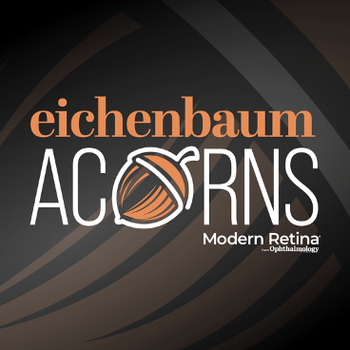
No one imaging tool fits all in identifying AMD lesions
Multimodal imaging, including traditional and newer techniques, is necessary for identifying the spectrum of retinal lesions associated with age-related macular degeneration (AMD), said David Sarraf, MD.
Reviewed by David Sarraf, MD
Multimodal imaging, including traditional and newer techniques, is necessary for identifying the spectrum of retinal lesions associated with age-related macular degeneration (AMD), said David Sarraf, MD.
In a review of the application of the different diagnostic modalities that can be used to characterize AMD-related pathologies, Dr. Sarraf, clinical professor of ophthalmology, Stein Eye Institute, UCLA, Los Angeles, indicated that large drusen (>125 µm), which are a defining feature of intermediate AMD, are best detected with spectral domain optical coherence tomography (SD-OCT).
SD-OCT is also essential for identifying reticular pseudodrusen, subretinal drusenoid deposits lying above the retinal pigment epithelium (RPE), Dr. Sarraf explained. Stage 1 reticular pseudodrusen are located underneath the ellipsoid zone and display a ribbon appearance with a hyper-autofluorescent ring, whereas the advanced stage III form illustrates a dot appearance and extend across the inner segment ellipsoid band.
These images illustrate the "ribbon" and "dot" forms of reticular drusen detected with spectral domain optical coherence tomography and fundus autofluorescence. (Images courtesy of David Sarraf, MD).
Drusenoid pigment epithelial detachments (PEDs) are large drusen (> 250 µm in diameter) that exhibit hyperfluorescent staining with fluorescein angiography but are hypofluorescent with indocyanine green (ICG) angiography. On SD-OCT, drusenoid PEDs display a discrete elevation of the RPE with homogenous hyperreflectivity under the RPE monolayer.
“These lesions have a very high risk for progression to geographic atrophy (GA),” Dr. Sarraf said. “The development of choroidal hypertransmission or a serous component within the PED typically heralds the evolution to the GA form.”
FAF best for RPE atrophy
Fundus autofluorescence (FAF) is the best imaging modality for tracking RPE atrophy, especially GA in AMD. Pioneering work characterizing the different phenotypes of AMD-related GA, defined by fundus FAF patterns, was performed by Frank Holz, MD, and colleagues. This group determined that the banded form and the diffuse trickling form progress the fastest.
“This is important information to consider when counseling patients and when designing research trials,” Dr. Sarraf said. He added that FAF is informative to identify mimickers of AMD, such as ABCA4 Stargardt’s disease.
Polyps are best diagnosed with ICG angiography, but can also be identified with SD-OCT. Polyps comprise a type I neovascular lesion and may be identified with SD-OCT on the underside of the RPE monolayer of a PED.
A PED is best illustrated with SD-OCT. Serous PEDs appear as well-circumscribed lesions with hyporeflective cavities and may be exudative or vascularized in nature.
Vascularized serous pigment epithelial detachment with a "hot spot" at the margin of the pigment epithelial detachments captured with fundus autofluorescence, indocyanine green angiography, and spectral domain optical coherence tomography.
“Vascularized serous PEDs may illustrate irregularity in the RPE monolayer corresponding to the type I neovascularization (NV) complex,” Dr. Sarraf said. “Vascularization can be identified as a notch or hot spot on ICG angiography. This notch or hot spot may illustrate frank neovascularization with OCT angiography.”
SD-OCT offers more for PEDs
Chronic fibrovascular PEDs can be identified with SD-OCT as a fusiform complex of highly organized, layered, hyper-reflective bands deep to the RPE, referred to as a multilayered PED.
Multilayered chronic fibrovascular pigment epithelial detachment detected with spectral domain optical coherence tomography.
“Large vascularized PEDs with a height greater than 500 µm may exhibit signs of RPE traction and are at risk of severe vision loss due to RPE tears, especially after anti-VEGF injection,” Dr. Sarraf said. “RPE tears are effectively detected with fundus autofluorescence.”
SD-OCT is an essential modality for the identification of type III retinal angiomatous proliferation (RAP) lesions that originate from the deep retinal capillary plexus. This imaging system is optimal to monitor the response of type III NV to anti-VEGF therapy.
OCT angiography (OCTA) is a novel advanced retinal imaging system that can identify the microvascular morphology of type I neovascular lesions and may also provide the opportunity to detect biomarkers of lesion activity, including secondary small vessel branching, peripheral arcades with anastomoses, and greater fractal dimension.
This optical coherence tomography angiography image illustrates an inactive type I neovascularization lesion with minimal secondary branching and no peripheral arcades.
“Area and vessel density with OCTA are not significant quantitative biomarkers early, but may provide important metrics with long-term follow up of type I NV,” Dr. Sarraf explained. “Other potential biomarkers of activity include secondary branching and peripheral arcade formation, whereas signs of inactivity include the presence of large, dilated straight vessels, absence of secondary branching or peripheral arcades, and lower fractal dimension.”
This optical coherence tomography angiography image captures progressive inexorable growth of a type I neovascularization lesion after two years of follow-up.
Dr. Sarraf added that long-term, serial follow-up of type I NV with OCTA illustrates the inexorable growth in the area and density of these lesions. It also provides both qualitative and quantitative evidence of sustained progression.
David Sarraf, MD
This article is based on a presentation given by Dr. Sarraf at the 2017 Retina World Congress. Dr. Sarraf receives research grants from Heidelberg Engineering and receives research grants from and fees as a consultant and speaker from Optovue.
Newsletter
Keep your retina practice on the forefront—subscribe for expert analysis and emerging trends in retinal disease management.












































